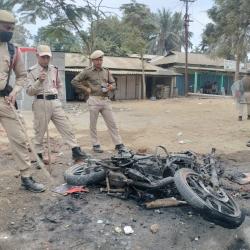Escalation of man-nature conflict
Straying of leopards in the crowded streets of Guwahati have become a far too often affair. The man-animal conflict is taking a toll, thus ringing a knell. There was a time when the most ardent adventurers had a hard time spotting these big cats, even in their most natural habitat. The ever-growing demand and more particularly the tendency of the human to plunder on anything to quench the unquenchable greed leads to the invasion into green pastures, the wild. In the process, the poor creatures - the ones that walk on the four feet and the ones that crawl are victimized. Their tranquillity is invaded. Elephant herds in large numbers have since long been invading villages in various areas of Assam in a spree to find food and there by causing damages to life and property. Birds too are diminishing in number; either migrating or perishing slowly.
A recent research states that the modern frequency communication network causes adversity to birds. Not to forget the fishes who are being killed in masses, only to be served as our delicacy. Perhaps this time, the leopards, secretary to the ‘king of jungles’ were just searching the High court to file a public interest litigation! May be they were out on a protest into the Guwahati streets to save their home and save our grace. Due to running out of hunting ground or rather preys, probably they are just out on the streets of the capital endangering lives, their own and the civilized ones too.
We have coldly witnessed these man-animal conflicts over the years, just counting the victims-both man and animal, without any outrage of emotions. Illegal deforestation has still being happening at an alarming rate and we are being the mute spectators. Sometimes I wonder if we have lost our voice, or ignored the grunts, or missed the outrage demonstrated the animals by flocking into the human domain.
Across the globe people have joined hands to “go green, save earth” motto, we seemed to have turned a deaf ear to these. We are rather on a spree to destroy our rich forests, our wild animals and their habitat, may be just to fatten our pockets. In process we are also endangering our own existence in the long run. People, the residents of Guwahati are petrified by the recent visits of the leopards. Already there are no less reasons of worry for the people here – floods, rising summer heat, traffic, scarcity of water and electricity. Sadly, no one else is to blame for all these plights but us. These all are the result of the man-wild or more wholesomely man-nature conflict. This time we simply cannot afford to remain deaf to the ringing knell. The need of the hour is to our voice for a more sustainable and Pareto efficient way. It is high time we realize and rectify our deeds to make the world a better place to live for all existing beings.
Other Contents by Author
Internally displaced women represents the epitome of the marginalization and the disenfranchisement of the dislocated in South Asia. Their identity and individuality are collapsed into the homogeneous category of 'victim' and community, devoid of agency, unable and incapable of representing herself, powerless and superfluous. In South Asia women being portrayed as ‘symbol of honor’, are often used as objects for contests of male power. They are raped, molested and tortured to shame the men of ‘other’ communities.The use of gender as a category of analysis is premised on the assumption that women experience dislocation and displacement in a particularly gendered...
Increase in the number of the internally displaced persons or IDPs (conflict induced) is primarily because of changing nature of warfare over the years. Besides sharp rise in internal conflicts due to ethnicity, religion, communalism, race, caste, separatists’ movements and various other reasons have added to this woe.
Cut off from their land, livelihood, income, and compelled to leave all but a few possessions behind, IDPs suddenly find themselves stripped of their means of survival.
The displaced are often stigmatised and also viewed with suspicion and hostility in the areas where they take shelter. They are vulnerable to acts of violence and human rights violations,...
Since the era of evolution, science, knowingly or unknowingly, has tremendously contributed to the progress of human kind making the race far superior to the other life forms on earth. In terms of providing comfort, convenience, safety and security from almost every imaginable threat, science has served mankind wonderfully well. Many of these have done wonders to improve not only the quality of life but the overall health of mankind.
A century ago an epidemic disease like small pox or cholera could decimate the whole population. But today with the breakthrough in medical sciences any such instance can be controlled. Diseases and disorders that certainly meant either death or a lot of...
A knowledge fair was held at Tinsukia from January 17-22, organised by the district administration in collaboration with several other organization was one of its kind. It was a mix and match of several interesting programs ranging from quiz competition, science exhibition, debate to fancy dress and flower show. It was also very culturally rich with the presence of well-known artists and scholars of Assam. The main attractions of the fair include Book Fair, Science Exhibition, Children’s debate and quiz competition, career counselling, adda and cultural programme.
Moreover a separate stall was set up in the memory of and also as a tribute to Dr. Bhupen Hazarika and Dr. Mamoni...
Right at the beginning of the year, four child scientist made Assam proud with their projects adjudged among the best 25 of India, against a total of more than 650 projects participated from all over India at the 19th National Children Science Congress held at Jaipur National University, Rajasthan from 27th – 31st December. Assam is the only state who could bag four positions within the declared best 25.
The four Toppers from Assam are, Devam Kakoty from Tinsukia district, Kandarpa Neog from Sibsagar district, Manash Pratim Talukdar from Barpeta district and Ronuj Dutta from Dhemaji district.
Devraj at 99th ISC
Devam Kakoty presented his project entitled ‘ Termite Soil -...










Add new comment